Last week, we enjoyed an initial foray into exquisite embroidery on piña cloth, a cloth made from pineapple plant fibers.
Many questions arose about the cloth itself, about the embroidery on the cloth, and about where to find piña cloth. The most frequently asked question, though, was what does the fabric feel like?
The latter is a very difficult question to answer via the internet! Today, we’ll look at old examples of piña cloth and a new sample, and I’ll do my best to answer your questions.
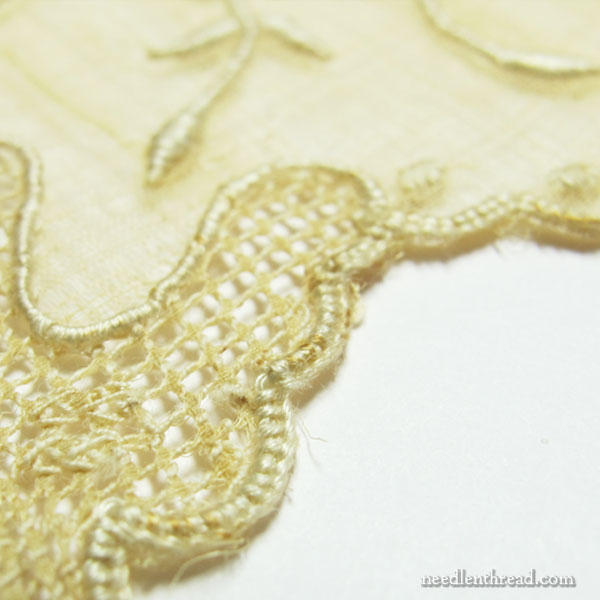
I took photos here on a white background, so you can get a sense of the color of these old pieces of piña cloth embroidery.
Remember of the videos about piña cloth from last week? Some images show embroiderers working on white-white piña cloth, and you can see many examples of the Barong Tagalog online where the cloth is white-white.
The fabric sample that I have is soft gold-ish color, and the old pieces of piña cloth, embroidered, that I have are also very soft gold in color as well, especially when placed on a white background.
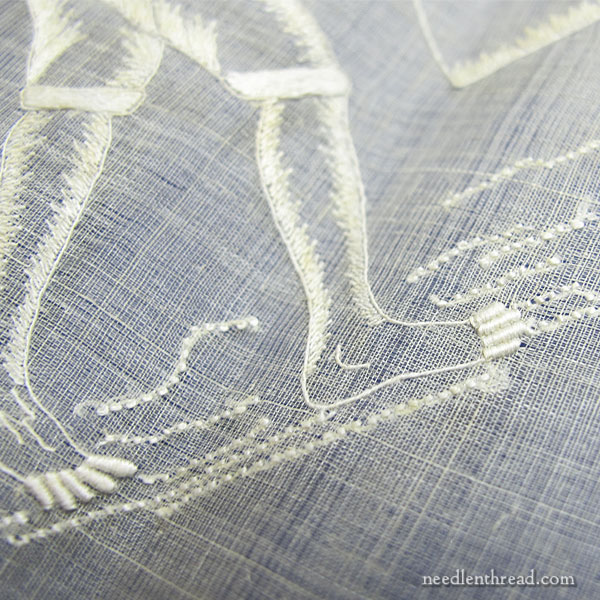
On a blue or a dark background like the one in the photo above, they tend to look more of a creamy off-white. (Great toes, eh?)
So, the soft goldish-white color seems to be the natural color of the fabric.
On the old pieces, the embroidery is done with cotton for the regular embroidery, and it looks like a very fine silk thread for the drawn thread work. The color of the embroidery on the old pieces is a creamy off-white, maybe an ecru.
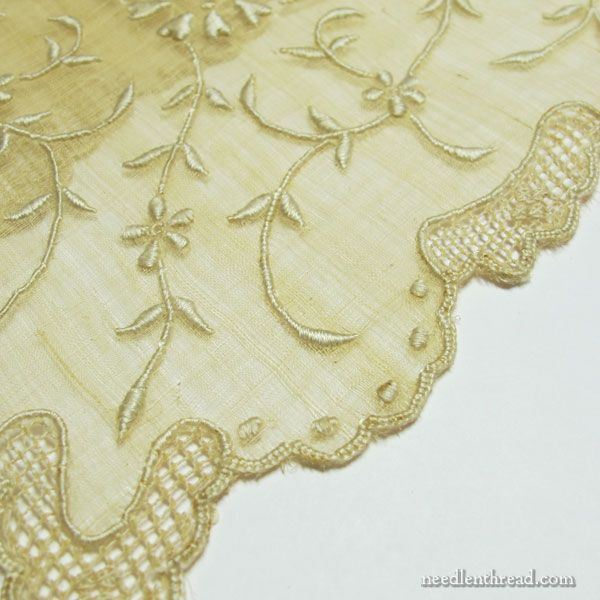
Here, on the white background, you get a sense of the gold color of the fabric, but you’re also seeing, I believe, some discoloration or darkening from age.
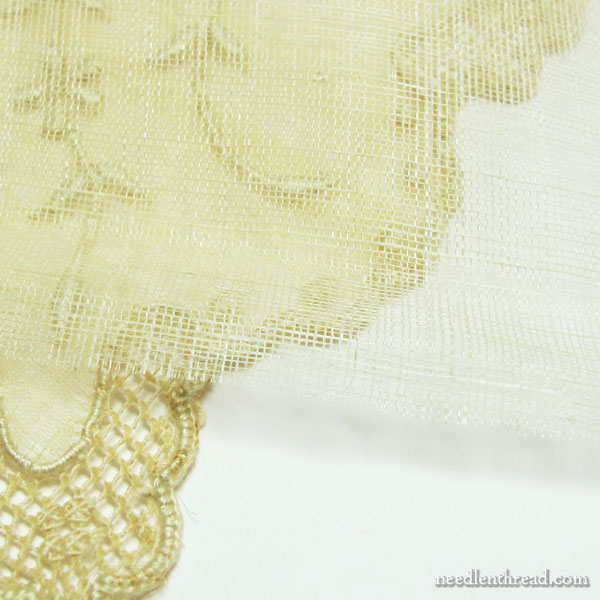
Enter, the new piña cloth, which is the gauzy looking overlay of fabric in the photo above.
It’s still a pale gold color, like a golden creamy white when viewed in one single layer – it’s definitely not white-white, nor is it as dark as the old cloth.
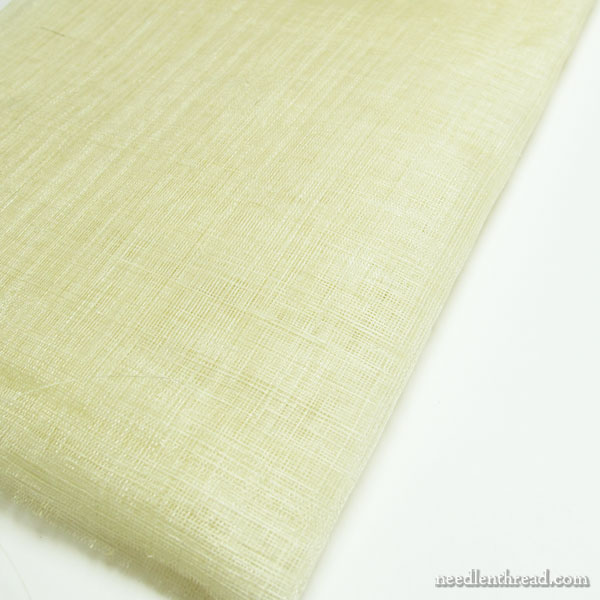
When the new fabric is folded, the layering makes it darker, but again, not as dark as the old fabric.
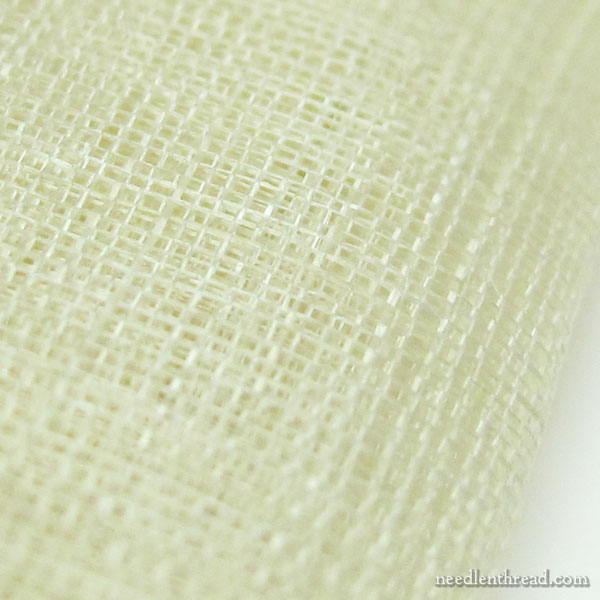
This is a close-up on the weave of the new fabric.
This particular piece (thank you, Anna-Maria, for ending it!) is made from all-pineapple fiber. The warp and weft threads are the same fiber, and I can take one tiny strand of that fiber and feel it and look at it under a magnifier, and see that it isn’t a combination of fibers.
Some piña fabric options I’ve seen on the market today combine pineapple fibers and silk, but traditionally, the cloth was not made with silk.
What does piña fabric feel like?
Well, this particular new piece has a nice, smooth hand, or surface feel. It is not slubby, bumpy, or anything like that. It feels good when you pass your hand over the surface.
But it does have a wiry stiffness to it, which will lesson over time (if I judge by the old pieces I have) and which definitely lessens with washing.
The fabric is quite delicate when it is wet, so special care has to be taken in the way it is washed. It’s also incredibly limp and smooth and silky when it’s wet! I’ll talk more about that later (if I can bring myself to tell you of my idiocy when washing one of the old pieces…)
Finally, piña fabric is as light as air. There’s virtually no weight to the 1/2-yard piece, and the embroidered pieces are extremely light as well. The only weight to them seems to come from the embroidery. You can feel the weight of the threads on the edges, but overall, the pieces are gossamer-light.
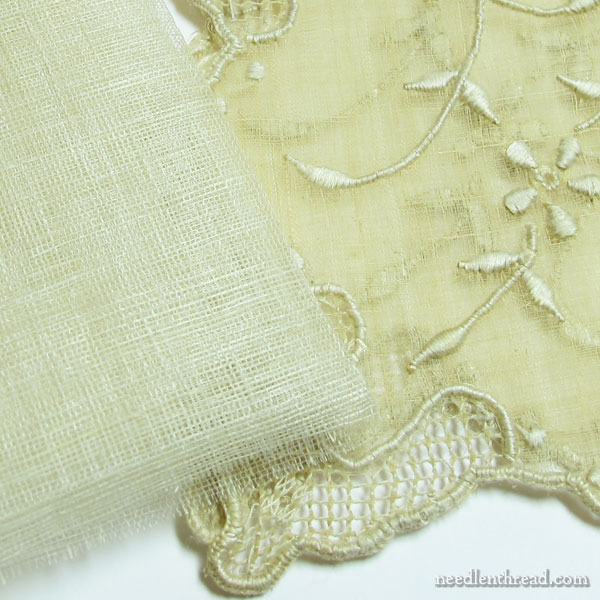
Here you can see the folded piece (in eight layers) of new piña cloth on the left overlapping two layers of the old embroidered cloth on the right.
Hunting for Piña Cloth
I have not found a source for real piña cloth in the US yet, but I’ve gleaned a bit of good advice from reliable sources, if you do plan to pursue finding and purchasing a length of real piña cloth:
1. Buy from a distributor who can order it for you. Do not buy online, directly from the weaver or coop in the Philippines. The industry is apparently quite disorganized, and you can’t be guaranteed of receiving the product.
2. If you have a friend in the Philippines who can hunt out piña cloth and purchase it for you, that works even better, as you can avoid several layers of middlemen.
3. Check the fiber content and the source of the fabric. If you’re paying $10 / yard for it, you’re not getting real piña cloth that is used for this type of embroidery. You’re either getting a blend or a machine manufactured cloth that is woven differently, and most likely from India.
4. The cloth width is narrower than what we are used to when buying fabric off the bolt. It is likely that the widest piece you’ll find is 26″ – 30″ wide.
5. Through a distributor, expect to pay at least $80 – $100 / yard (and sometimes more, depending on where you can get it) for real piña cloth.
I’m still working on cleaning the old pieces of piña embroidery. It’s a painstaking, long-soaking process, and admittedly, I’ve made some mistakes along the way. Eventually, I’ll tell you all about it…
Have a swell Friday!







Fascinating reading, thanks Mary. I tried to track down some Pina cloth quite a while back but no luck yet. I saw the most exquisite example of embroidery on Pina in the old Lace Museum in Nottingham in the mid 80’s which stopped me in my tracks. Sadly the museum has closed and the Nottingham castle which I was referred to has no trace of the embroidery – embroidered by a nun as I remember it. I’d love to see that embroidery again. Funny how some things stay with you.
Hi Lyn,
I’m an exporter and distributor of piña fabric and piña silk from Manila, Philippines. I understand how hard it may be to obtain piña cloth in the States and would love to help anyone in obtaining some.
Please feel free to email me at pearltan316@gmail.com if you’re interested and I’d be more than happy to help!
Best,
Pearl
I was able to purchase two large pieces of pina from a woman in Wisconsin. One is hand embroidered on one end, and is black, but has about two yards of unembroidered fabric. This piece I believe to be 100% pina. It looks a lot like the newer piece of fabric you show, Mary. It is very lightweight and is slightly stiff. It feels natural to me. It clearly looks like it’s been handwoven, especially on the edges of the fabric.
The other piece is an ecru piece, but it is much different from the other one. The individual threads are much smaller, and the weave is a lot tighter. The fabric feels smoother, and to me has a manmade fiber feel to it, like organza. This fabric has a selvage, which implies to me it is not handwoven. It is slightly shiny. I did a burn test on a snippet of this fabric, and while it created an ash, it looked like it was half burning, half melting. I suspect this fabric is not 100% pina. Probably a mix of pina and something else, but the fibers are so small it is hard to say.
The women said both pieces were purchased in the Philippines by a friend, and she was selling the fabric with the proceeds going The Sewing Machine Project. So I didn’t feel so bad about paying what I did.
I haven’t yet received my pina/silk sample or banana fiber sample from the distributor in New York, but I will report on those when they arrive.
Looking forward to your next installment on the pina cloth!
Thank you for sharing this journey with us Mary! The exquisite embroidery reminds me a bit of the Appenzell white work. The patience that goes into these pieces. It makes me so happy to see them. Have a nice weekend, Jessica
I hadn’t thought of Appenzell Jessica but you are soooo right. Although from different ends of the earth and with totally different climates and plant material these embroideries have beautiful similarities – the Creme de la Creme of whitework.
Dear Mary
An interesting read and a fascinating cloth and beautiful embroidery. What will you use the cloth for? it looks as if it would be a difficult cloth to embroider on it’s so fine. I watched the video on making the cloth and You must be delighted that you have such a piece of cloth made out of pineapple leaves, it’s so labour intensive to create such pieces no wonder it is so expensive. Thanks for sharing the information on the look and feel of pina cloth really interesting.
Regards Anita Simmance
Hi Mary!
This pina-cloth is very interesting, I never heard of it before. I wonder, the new cloth seems not to be as fine and looks more like mull/lint (if this is the right word…) to me. Would you say there is a big difference? Or might it be because the old piece is worn and washed, that the difference occurs?
Always delighted to read another article!
Marion
Pina Cloth can be purchased by the yard (NOT inexpensive) from Nancy’s Sewing Basket in Seattle, WA. They do not have unlimited quantities, but they do have some.
Mary when my daughter was a baby I often dressed her in very finely made baby dresses that were hand embroidered with matching petticoats. They were inexpensive, and I even bought these little outfits for my daughter and daughter in law for their babies. The labels said, made in the Philippines. Later they were sold in upscale baby shops, but now are no longer available. The cloth was beautiful. Is that pina cloth, and are these outfits still available? I cannot find them anywhere. They came in white and pastels. elizabeth
It would be hard to know, Elizabeth. The Philippines has had a strong history of creating finely embellished clothing for export on all types of materials.
Mary I hope you aren’t disappointed when I say I am not in the least averse to hearing of other people’s disasters. It somehow lessens the severity with which I berate myself for my own stuff-ups, er, mistakes.
I would really love to get my paws on some of this fabric, just because it is so different. I shall await further information from you or one your followers as to the best online source. Hopefully someone will know something.
PS The toes are stunningly gorgeous.
Absolutely gorgeous, but no wonder it’s so rare and expensive! http://www.cool-organic-clothing.com/pina-fiber.html
When I looked for pina cloth after my return from Hawaii, I found lots of references to to purchase it. Eventually I found only two factories from the Philippines which claimed to make it but when I looked further into the content of the fibers none of them were strictly from the pineapple plant or from that plant at all.
Hello, I am looking for a buyer for my vintage pina cloth. My Grandparents brought it back from the Philippines in 1938. I have 3 rolls of natural color that are each 4 yds by abt 25″ wide. There is another piece that has been cut, I can send a sample of that. I also have 4 yds each of medium purple, tangerine, and green. Aside from that I have two pieces abt 2yds long with embroidery of purple flowers on one & green balls on the other. Please let me know whether you or anyone you know would be interested and how much you would pay.
Hi Sandi I am interested. How can I get in touch with you? My email is ar100792@gmail.com Thank you.
I’m really interested in using this fabric but I haven’t found any in any of my local stores…
Where can I get some of this fabric online
I have four rolls of natural antique pina cloth, 1 each of solid green, orange and purple, and 1 natural embroidered with purple butterflies and one natural with green balls. They are all 25 inches wide by 12 feet long. My grandmother bought them in the Phillipines in the late ’30’s when my grandfather was posted there. They were originally stored in mphor chest and then rolled in acid free tissue paper when I got them. They seem to be in great condition. I would like to sell them. Are you interested?
So have you got a happy ending to your piña cleaning adventures? I have a vintage piña tablecloth and napkins which I inherited from my parents which I’d like to clean. I assume that rolling all these items once they have been cleaned will be better that keeping them folded as they were when they came to me.
I think rolling them is a good idea. I soaked mine in a mild bath of Ivory liquid soap and warm water. It helped somewhat. I laid them flat to dry and to store.
Thank you for a great article. I have two very large 100% pina table cloths that belonged to Imelda Marco, and were purchased from Christie’s auctioneer in New York many years ago. I have been interested in selling them but have not been able to connect with people who even knew much about the fiber and its value until I read your article. Where would you suggest I go to sell my table cloths.
Anjel, Did you sell your tablecloths?